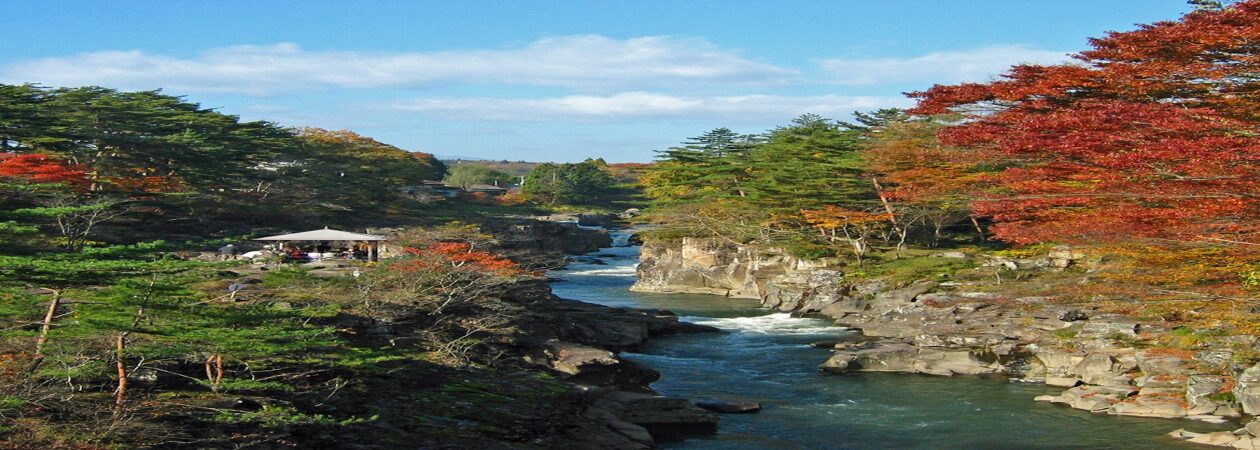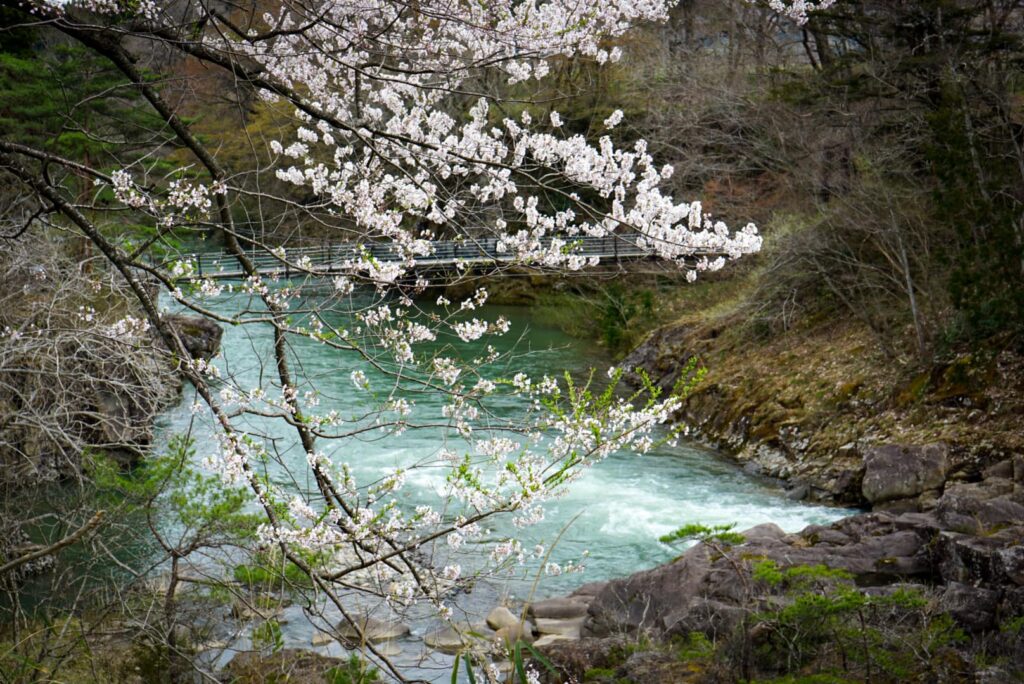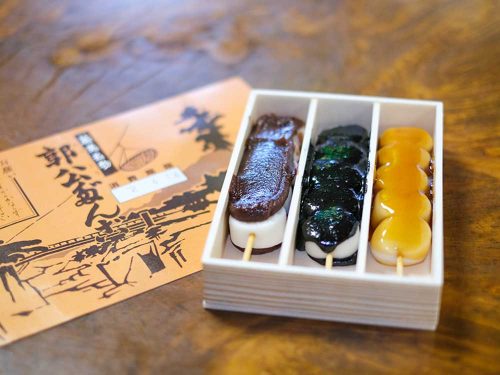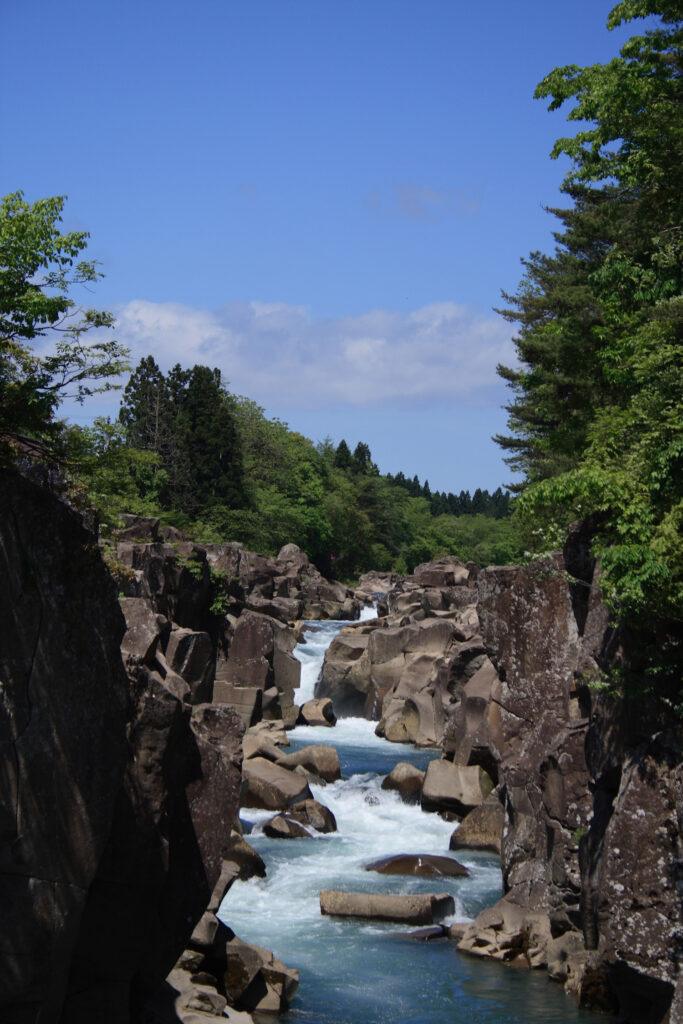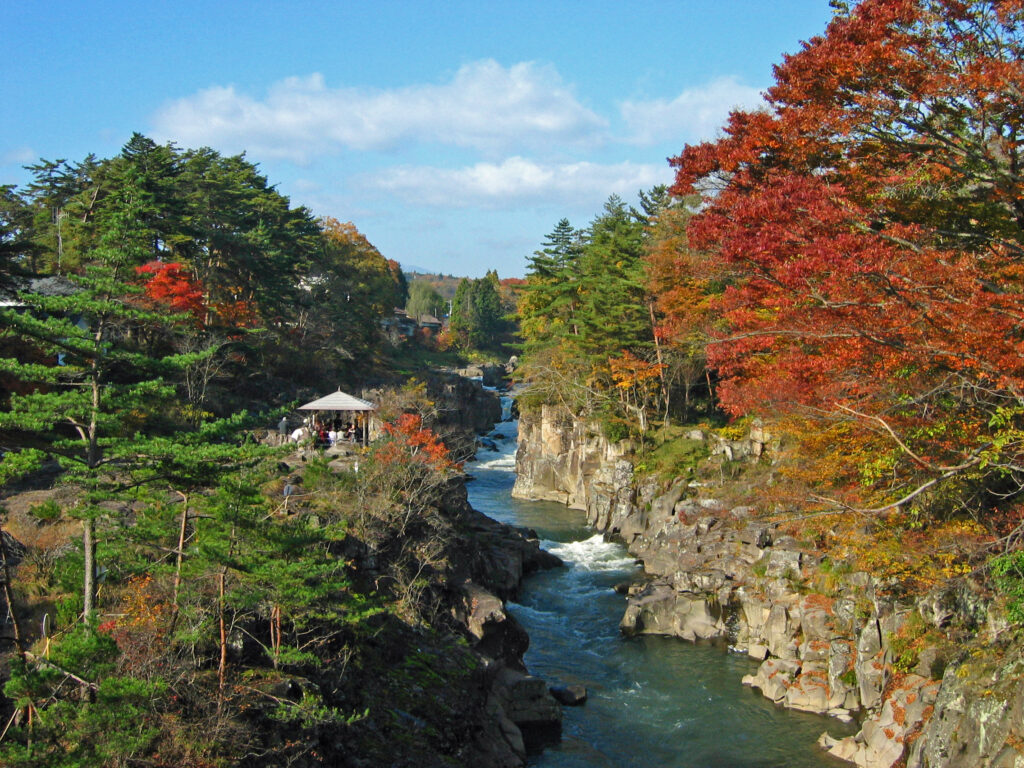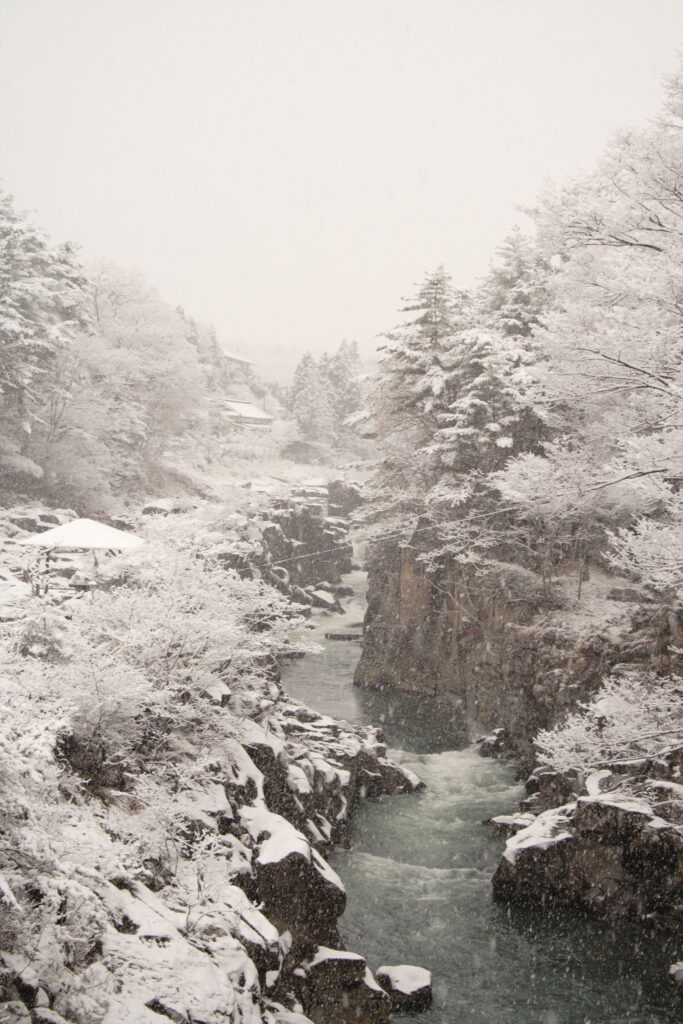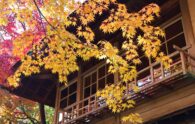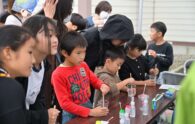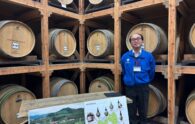The transition of the four seasons in Iwate Prefecture are clearly defined, bringing with them the pleasures of changing scenery and seasonal food. In this article, the Genbi Community Center introduces the seasonal delights of Genbikei, which is located in southern Iwate prefecture, 9km from World Heritage Site, Hiraizumi, and is registered as a National Site of Scenic Beauty and a National Natural Monument.
Spring——. The Iwai River, formed by the rapids of meltwater pouring from Mt. Kurikoma, which glimmers white with the remaining snow, carves Genbikei, a valley consisting of waterfalls of varying sizes and unique rocks formations. The trees beside the river, with their sprouts and new leaves that have survived lengthy winters, give you a sense of life’s resilience and a breath of spring. Locals, in particular, are looking forward to the cherry blossoms that decorate the riverfront.
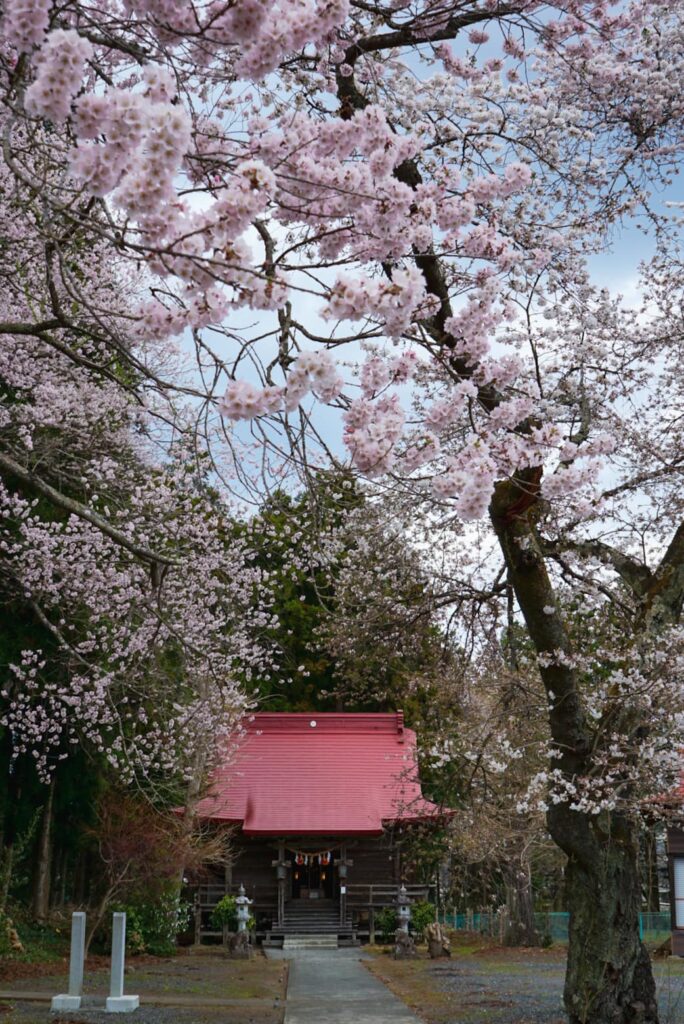
Yoshino and Edohigan cherry trees are the most common blooms in Genbikei. It is said that the Edohigan trees were planted in the middle of the 17th century by the order of feudal lord Date Masamune, who was in charge of the area. They are known as Teizanzakura, deriving from Masamune’s pen name ‘Teizan’. Teizanzakura are natural monuments declared by Ichinoseki and are located in the precincts of the Onsen Shrine on the north side of the valley and on the left bank of the Iwai River. Back in the early 12th century, Minamoto no Yoshitsune, who was staying at World Heritage site, Hiraizumi, also adored the scenery of Genbikei, and is said to have often visited by horse.
In Japan, there is a proverb, “Hana yori Dango” – which translates to dango (skewered rice dumplings) over flowers. It means that dango that satisfy hunger are appreciated more than cherry blossoms that are only there to be looked at. One of the specialties of Genbikei is the flying dango. A basket of dango and tea fly along a zip line across the river. In Japan, there is a saying “reality always falls short of reputation”, but Genbikei’s specialty dango, are no doubt exquisite.
Summer——. Perhaps due to the effects of global warming, it is not uncommon for summers to have temperatures exceed 30 degrees Celsius. However, Genbikei, has a refreshing breeze that blows across the valley, giving it the feel of a summer retreat.
The Terui Weir, which is used as agricultural water upstream, receives a large volume of water from the Iwai River. As the water level drops, potholes appear here and there on the river bed. These potholes form when the pebbles that stay in dents of the rock surfaces rotate in a fast flow, scraping the surface to create a hole. Genbikei is designated as a national natural monument due to the large number and variety of potholes.
Seasonal flavours of summer vegetables such as eggplants, cucumbers, peppers and tomatoes pique the appetite. Edamame, a must-have accompaniment to beer, is also a treat. Roadside Station Genbikei near Genbikei gorge, is where you can find seasonal vegetables as well as ‘mochi cuisine’, a Japanese soul food that is served year round.
Autumn——. “Yama (mountain) moyuru (ablaze)” is an expression to describe autumn leaves. Autumn in Genbikei is marked by the red of maples and sumacs, as well as the green of pine trees that line the valley and the river’s surface. The contrast between the blue of the water and the brown of the rock surfaces is beautiful and subtle. The three bridges of Genbikei are the Goranba Bridge, a rickety suspension bridge, the centeral Tengu Bridge, which is regularly bustling with tourists, and the Chojataki Bridge in the upstream, which is made of bamboo rather than reinforcing bars. If you want to soak in the autumn hues of Genbikei, we recommend walking along the promenade route, which will take you across the three bridges.
When we talk about autumn foods, we must first and foremost mention rice. The main variety is Hitomebore which is famous nationwide, and new rice is exceptionally delicious. Fruits that have just been picked are also recommended. Tourist wineries and apple orchards sell directly nearby.
Winter—–. Snow flutters in December. We welcome the arrival of migratory birds such as swans and geese. Genbikei takes on the appearance of a snowy landscape, with the rock surface becoming moist and glowing black, creating a magnificent landscape reminiscent of an ink painting. In and around Genbikei, there are hot spring inns where you may dine sashimi or seafood dishes fished off the Sanriku coast, as well as enjoy meat dishes like shabu-shabu of Japanese black beef. These regional foods go well with Yukimi sake.
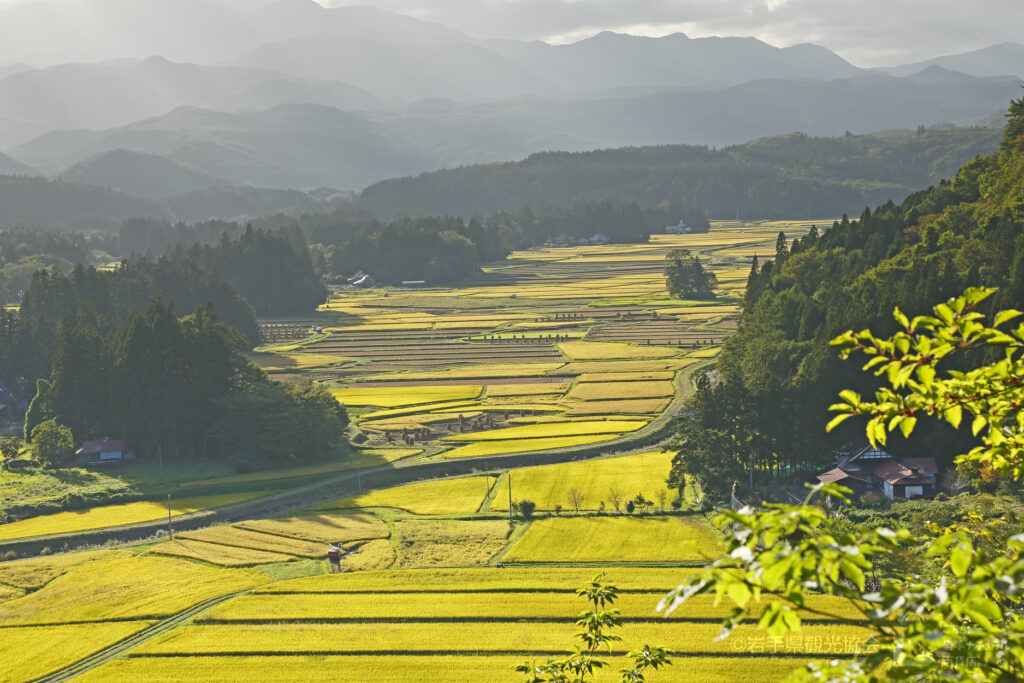
On the north side of Genbikei, there is a city museum adjacent to the Roadside Station Genbikei, where you can learn about the region’s history and culture. If you go a little further to the west, you will find the Honderamura Estate, which has been designated as a national cultural landscape for preserving its rural landscape from the Middle Ages. Wakamikotei has a shop, a restaurant, and museum. Matsurube Snowland is located further west and offers skiing and snowboarding. Within a 20km vicinity to Genbikei, the area full of appealing activities, even in the winter.
How did we go? Did the article help bring about the imagery of the Genbikei in spring, summer, autumn and winter? We hope that one day you will visit Genbikei and enjoy the scenery and seasonal foods. We’re looking forward to seeing you in future.
Japanese
四季折々の厳美渓日本には四季があります。特に岩手の四季は春夏秋冬の移り変わりがはっきりしていて、四季折々の風景や旬の食べ物などが楽しめる地域です。今回は、岩手県南に位置し、世界文化遺産の平泉へも9kmと割と近くにある、国の名勝天然記念物となっている渓谷美が素晴らしい「厳美渓」を紹介します。
【写真① 春】
春------。厳美渓は、残雪で白く輝く栗駒山から流れ出る雪解け水が磐(いわ)井川(いがわ)となり、その急流が創り出した大小さまざまな滝や奇岩からなる渓谷です。
川沿いの木々は、長い冬に耐えた新芽や若葉が生命の逞しさや春の息吹(いぶき)を感じさせてくれます。その中でも地域の人々は川岸を彩る桜の開花を心待ちにしています。
【写真② 桜】
厳美渓の桜の種類は、ソメイヨシノとエドヒガンが主です。エドヒガンは17世紀の中ごろに、当地域を統括していた伊達藩藩主の伊達(だて)政宗(まさむね)公が命じて植えられたと伝わっており、政宗公の雅号「貞山(ていざん)」に因んで貞(てい)山桜(ざんざくら)と呼ばれています。貞山桜は渓谷の北側に鎮座する温泉神社の境内(けいだい)や磐井川左岸の所々にあり、境内内の貞山桜は一関市指定の天然記念物となっています。また、もっと古い時代の12世紀初頭には、世界文化遺産の平泉に滞在していた源義経(みなもとのよしつね)公も厳美渓の景色が気に入り、たびたび馬で遠乗りに訪れたと伝えられています。
【写真③ 団子】
なお、日本には「花より団子(だんご)」という諺(ことわざ)があります。眺めるだけの桜の花よりも、空腹を満たす団子のほうがありがたいという意味です。厳美渓の名物の一つに空飛ぶ団子があります。川の向こう側からワイヤーを伝わって、団子とお茶の入った籠が飛んでくるのです。日本には、「名物に美味いものなし」という諺もありますが、厳美名物の団子は間違いなく絶品です。
【写真④ 夏】
夏------。地球温暖化の影響かもしれませんが、夏は気温が30度を超える日も珍しくなくなりました。けれども、厳美渓は渓谷を吹き抜ける涼風が気持ちよく、避暑地の様相(ようそう)を呈しています。磐井川は、上流で農業用水となる照井堰(てるいぜき)へ多くの水を供給するため水位が低くなり、川底のあちこちに甌(おう)穴(けつ)が顔を出してくれます。甌穴というのは、岩肌の窪(くぼ)みに留まった小石が速い流れの中でくるくる回転し、岩肌を削ってまるで甕(かめ)の底のように穴が開いた状態になったものです。厳美渓の甌穴は、その数と種類の多さから国の天然記念物となっています。
夏に食欲をそそるのは、何といっても夏野菜たちです。ナス、キュウリ、ピーマン、トマトなどが旬の味を楽しませてくれます。ビールのおつまみに欠かせない枝豆も美味しいですよ。厳美渓の近くに道の駅「厳美渓」があり、そこで旬の野菜をゲットすることができます。また、日本のソウルフード「お餅料理」も、一年中そこで食べることができます。
【写真⑤ 秋】
秋------。日本には「山燃(やまも)ゆる」という表現があります。秋の紅葉(こうよう)を表す言葉です。厳美渓の紅葉は、モミジやウルシの赤色と松の緑色、渓谷の川面を彩る青色、それに岩肌の茶色が微妙なコントラストを醸(かも)し出し、とても綺麗(きれい)です。厳美渓には、結構な揺れが楽しめる吊り橋の御覧場(ごらんば)橋(ばし)、観光客の往来で賑わう中央の天工(てんぐ)橋(ばし)、構造が鉄筋ではなく竹筋となっている長者(ちょうじゃ)滝(たき)橋(ばし)の3つの橋が架かっています。厳美渓の紅葉を愛(め)でるなら、この3つの橋を渡って散策するプロムナードコースがお薦めです。上流にある長者滝橋の名前の由来(ゆらい)となっている長者滝には、厳美の長者(ちょうじゃ)に恋した小松姫が、はるばる京都から長者を訪ねてきたが会えずに、厳美渓に身を投じてしまうという悲恋の「小松姫物語」伝説があり、紙芝居にもなっています。小松姫に思いを馳せながら散策する秋の夕暮れもおつなものです。(ここは英語版ではカットしました)。
また、秋の味覚を満たしてくれるものは、まずはお米です。この地域では「ひとめぼれ」という品種が主で全国的にも人気があり、特に新米は美味しいのです。そして、とれたての果物もお薦めです。近くには観光ブドウ園やリンゴ栽培農家が直売しています。
【写真⑥ 冬】
冬-----。12月になると雪がちらつきます。白鳥や雁などの渡り鳥も飛来します。厳美渓も雪景色となり、岩肌も濡れて黒く光り、まるで水墨画のように幻想的な風景となります。厳美渓やその周辺には温泉旅館があり、温泉を楽しみながら、リアス式の三陸の海から獲れた魚介類のお刺身や海鮮料理あるいは黒毛和牛のしゃぶしゃぶなどの肉料理が 堪能(たんのう)できます。地元の料理を肴(さかな)に雪見(ゆきみ)酒(ざけ)と洒落(しゃれ)るのも一興(いっきょう)です。
【写真7 田園風景】
厳美渓の北側には道の駅「厳美渓」と隣接して市立博物館があり、この地方の歴史や文化に触れることができます。もう少し足を西に伸ばすと、中世の農村風景がそのまま残っている、国の文化的景観に指定された「骨(ほね)寺村(でらむら)荘園」があります。交流施設の「若(わか)神子亭(かみこてい)」には直売所とレストラン、資料館が併設されています。さらに西へ向かうと、スキーやスノーボードが楽しめる祭畤(まつるべ)スノーランドがあります。厳美渓から20km程度とそんなに遠くなく、冬季でも魅力いっぱいの厳美地域です。
皆さん、いかがだったでしょうか。厳美渓の春夏秋冬をイメージしていただけましたか。いつの日か、厳美渓にお出でいただき、四季折々の風景や旬の食べ物を楽しんでいただければ幸いです。お待ちしております。
